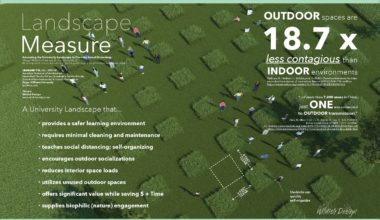As many higher education institutions in New England grapple with how to safely reopen in the midst of the coronavirus pandemic, the physical setting of campuses becomes paramount. Indeed, NEJHE recently published a piece on the advantages of small rural campuses in the age of social distancing. Here, Leonard Yui, an associate professor of architecture at Roger Williams University in Bristol, R.I. and director of Wildish Design, a design and research practice dedicated to rewilding the world, has offered the following …
Following is a modest design proposal to transform a university lawn into an outdoor classroom marked for social distancing. It promotes a safer learning environment, helps build intuition about the six-foot separation and activates outdoor spaces for both people and wildlife.
 Click here to view and download the Landscape Measure design proposal.
Click here to view and download the Landscape Measure design proposal.
The early science is gradually showing that outdoor spaces are safer than indoor spaces for COVID-19. One research study from Japan found that COVID-19 transmission was 18.7 times greater indoors than outdoors. Another article from China found that, of 7,300 active COVID-19 cases, just one was connected to outdoor transmission.
Indoor spaces were never designed for social distancing and many are now depending on aging climate controlled systems for viral filtration. These limitations are now muddied by politics, finance, marketing and logistics, raising the urgency to consider safer options.
Outdoor classrooms too have limitations compared to their indoor counterparts. What do we do about the sun, cold, heat, rain, etc., especially in New England? And where do we place the projectors, desks, seats, etc.?
It seems unthinkable to allow students and teachers to be exposed to the elements, but in 1907, Providence, R.I., did just that by experimenting with the first “fresh-air” schools in the U.S. to combat the tuberculosis epidemic. Pioneered by two women doctors, the idea was to open an entire classroom wall to the frigid New England winters and bundle the students up with sleeping bag-like sacks with heated stones. It was so successful at reducing the health risks that it triggered a movement across the nation that lasted for nearly 50 years. Many advocates today, backed by recent science, are trying to bring these methods back.
The “fresh-air” classroom movement gives us a model for opening school while managing the elements with devices like tents, umbrellas, heaters, jackets and so on. What may be lost by focusing overly on environmental and spatial adjustments is how pedagogy too can change and influence new landscapes. The proposed six-foot plots are more than just a measure of distance between two people, but a reflection of a complex non-classroom world wrestling with issues of health, race, wealth and climate inequities. The move outdoors is also a metaphor for adapting our beings to wild variables of society and to engage, first, those social and ecological issues that are near—that directly touch us.
Outdoor spaces can be mocked up like traditional classrooms, but they can offer more because of the COVID-19 restrictions. Safer outdoor places permit more opportunity for student interactions, larger spaces allow for groups to form personalized patterns, and the natural elements provides a dynamic background for interaction. Digital assets could supplement these offerings by having students pre-download slide presentations and use their phones as mini projectors. By extending wifi signals, students could use Zoom as a video/audio connection, and digital tablets could serve as whiteboards.
On a more imaginative path, the lack of walls, roofs and boundaries mean the class is not confined to a location or simple desk patterns. The field of environmental education recommends using outdoor experiences as part of developing broad individual awareness of “how people and societies relate to each other and to natural systems.” A philosopher-colleague reminded me that the Ancient Greeks preferred talking and sharing their thoughts while going on long walks. Using the “Socratic method” with a walk-and-talk method might encourage students to make links between course topics and physical locations that have specific meaning for them. In the business world, professionals often do key “business” transactions in transitionary (between meetings) or relational (like dining) interactions.
None of this is a substitute for the traditional indoor classroom, but the current circumstances beckon more creative negotiation among places of safety, convenience and learning. Simply going outdoors is one step, but another more enticing and sustainable direction is to reshape the celebration of pastoral landscapes to places that connect us more deeply to the outside world, both figuratively and literally. These changes can be small, sporadic and scattered around many places, but in aggregate, and over time, they should make a valuable impact to safety and culture and promote a more animated learning place.
[ssba]
